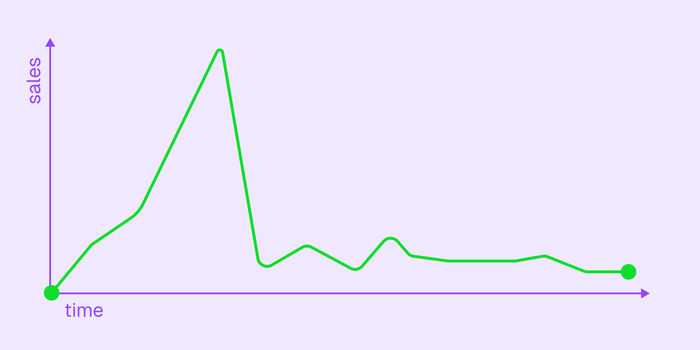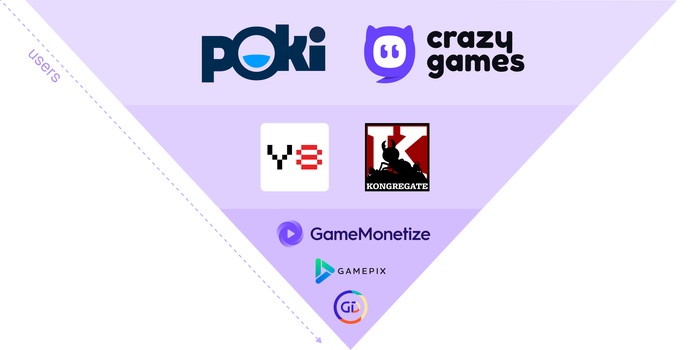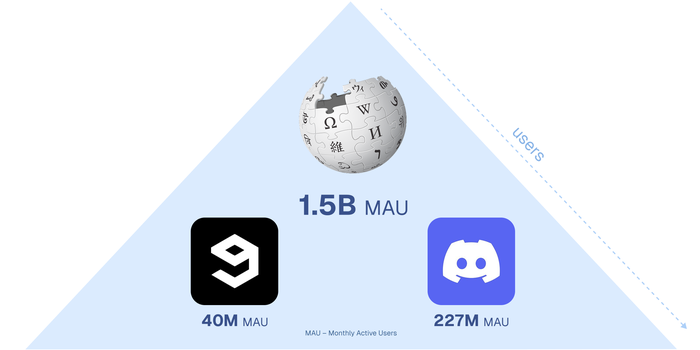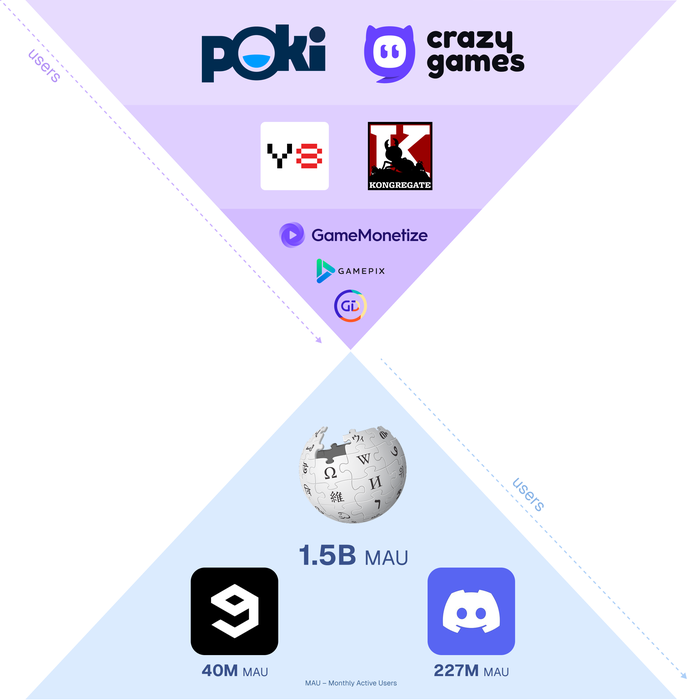Over the last couple of years, we’ve been working with developers and platforms from all over the world to remove barriers in the field of web game publication. Through this journey, our team learned a lot and I want to share some of these findings and organize these highlights in a series of articles. We’re going to talk about the distribution, monetization, and the production of web games.
In this first post, I want to discuss HTML5 games and where to sell them. This is our first take on this complex problem, and if you find this useful, keep up to date with the rest of the series.
So you have a game, ideally several, and all of them are hosted on one platform. Maybe a couple of platforms. Usually when we talk with developers, these are the reasons they give for choosing specific hosting services:
-
Organic traffic—this platform has a lot of users, who are discovering our game and spend a lot of time with it.
-
A lot of visibility—thanks to the peculiar positioning of our platform we are getting additional eyeballs on our game!
-
No marketing expenses—we do not spend any money on marketing, which is kind of insane in the era of mobile stores and over-saturation. It is, frankly, a dream.
-
Monetization—we are getting revenue right here, right now.
-
Easy—we can create a hyper-casual game in under a month and start earning immediately.
-
Web—everyone using the platform can start playing in no time on any device.
-
No region restrictions—no questions here. It just works where I live.
Ok, so this is all fine and dandy, but the question still remains, what do I do with all those games? Do I just keep operating them forever? Well, there’s always some challenges to that, here are just some:
-
The long tail is not long.
There’s no way to go but down. We’ve learned this the hard way. Most dev graphs (which they will be very reluctant to show you) will mostly look like this. A spike and then a slow death.

Image via author.
-
Difficult moderation & competition
Publishing a new game on our platform of choice is getting more and more challenging. The growth of requirements and restrictions is mostly caused by the growth of competition. There are more and more games being uploaded to the platform every day, and our games are just getting squeezed.
You could say, “Well, I’m just going to build a new game, and I will keep building these new games, catching waves and capitalizing on them.” However, building a new game requires time and money. Even if you work alone, it’s still going to take time to do and there’s no guarantee your idea is going to work.
The fourth reason is that you don’t know what’s going to happen. You just don’t. Instead of placing all your eggs in one basket and hoping for the best, why not try to diversify, and help yourself make more money in new places.
Let’s sum up. You have a number of games, they are localized in English, and can work on the web. You know they are profitable, you know there’s enough retention and ad views, and you know people like them. So here comes the next question – What can you publish?
Where can we publish?
I’m not going to waste air persuading you to build games for the web. However, I do want to give you some numbers to use as you see fit to figure out what to publish.
Time to develop: 1-3 months. Including testing.
Cost: under $10 000.
Competition: Monkey Mart (300M plays), Level Devil (83M plays), Stickman Hook (574M plays), Subway Surfers (1B plays).
The last row of numbers were taken from the presentation done by Poki rep to the Defold community. Yes, Subway Surfers is there, but the other games on the list are much smaller. They do have good quality though, so remember, when you go big – try to keep up.
Where can we publish?
I think of the web game distribution market as an inverted pyramid.

Image via author/respective brands.
-
There’s the top tier that includes platforms like Poki and Crazy Games. Poki has about 30 million monthly active users (MAU) – this is the metric that is traditionally used to calculate the general audience of the platform. 700 billion gameplays/month on Poki. Crazy Games has similar numbers 30 MAU and 300 million games played monthly.
-
The middle layer is all kinds of other platforms. This includes the likes of Y8, Kongregate, and Newgrounds.
-
And then there are these aggregators, like GameMonetize, GamePix, Game Distribution. GameDistribution for example has over 2000 web publishers on their platform.
However, this is just the tip of the iceberg. This inverted pyramid is what the platforms want you to think of the web game market, so you don’t move from that platform. The reality is that under that peak there’s a whole other space for web games that has remained invisible for years.

Image via author/respective brands.
Again, let me take one moment to break it down.
First we have websites. Look at the graph from Statista below. In the year 2021, there were 1.88 billion website launches. All of these websites launch and die, with a large number of them growing, maturing, and slowly decreasing their influence. This last part of their journey is something that we are most interested in!

Image via author/respective brands.
When businesses understand that their website lifespan is close to its end, they need to find ways to revitalize their user base. Another reason to push them towards games— they need to find new ways to show ads. Games often become a perfect medium for this, attracting users and increasing the return on ad spend (ROAS). This is increasingly becoming part of the strategy for not only smaller websites, but also larger media platforms like The New York Times.
Social media platforms, chat platforms, streaming platforms—all of these spaces are embracing games! Discord has games, Viber has games, even Linkedin has games. This is possible thanks to the HTML5, and the way this content could be easily integrated into any online service. Even places like Wikipedia could potentially find a place for games.
Note about Mobile Stores
Apart from these general platforms, there are also web-app stores, like Chrome Web Store, where you can potentially distribute games yourself. For this, you can use packaging tools like Electron. You can also go to mobile stores like App Store and Google Play. Currently there are 250,068 mobile games on Google Play, with the top grossing backed by large publishers with deep pockets.
Here’s the math for you. If you publish on mobile, you need to invest at least 25% of the budget into marketing, plus pay a 15-30% service fee for each dollar of revenue. If you choose to sign up with a publisher, be ready for the 30/70 split, where 70% goes to the publisher’s pocket. For many developers this kind of spending is completely impossible.
With this in mind, the underlying opportunity seems to be humongous. With billions of websites all over the world and easy seamless integration, why do we keep limiting ourselves to chosen platforms, and not diversifying our distribution?
With that out of the way. How do you get to that sweet new audience on the web?
Challenges of Self-Publishing
On paper it should be easy. You go to Poki and Crazy Games, they approve your game, and you reap the benefits. However, practitioners will know that almost immediately they will be hit with a refusal, or they will just ignore you and never get back. This happens mostly because of quality issues.
Moderation on these platforms is usually being done on two levels: technical compatibility and IP compatibility.
Technical requirements are usually fairly rigorous, and require important features like a save system, player progression, ad monetization (banner, interstitial, rewarded), in-game purchases, social features (share, invite a friend, add to favorites, etc.), leaderboards, language and device information, and remote configuration.
IP compatibility is an overview of all the content you have in the game. The platform needs to make sure that there is no content that violates IP rights from their legitimate owners. This can be quite restrictive, especially for titles with no original content.
It is worth noting that even if you go through the moderation process on one platform, you will still have to do it for the competitors: big and small. The further you go, the lower the requirements become, but the higher the risk that the project will not be making any money.
Don’t miss out on the opportunity
No matter how you are going to address these challenges, I would encourage you to do it. The main reason being the longer you wait, the more opportunities you are going to miss. The way the web games are progressing today, they have the potential to become gateways to new markets and amazing new adventures for the industry.
How to do it—that’s another question. I see three options so far:
-
You can do it yourself. Get a separate employee, or be that employee, who’s going to attack each and every platform, look at each and every store and aggregator, and try to get there yourself. It’s time-consuming, but you’ll learn a lot.
-
Publisher. Publishers are expensive, you will lose on a lot of money, but if they do pick you up, you will know for sure your game is worth it and you will be making money. But note that the publisher will probably take over 70% of it.
-
Game distribution and monetization platforms. To operate in such a vast and fragmented market, new and efficient tools are essential. At Playgama.com, we’re bringing to life this kind of vision—a unified platform that connects the entire web and serves as a gateway to the widest possible network of distributors and platforms worldwide (we talk thousands), both gaming and non-gaming. I believe this is the future, and it’s coming very soon.
We enter a new stage in the way entertainment is consumed. This new stage will disrupt not only the way we access games, but also ways we monetize and distribute them. We are at the brink of the huge explosion of opportunity for game developers and publishers. The pie is bigger than you think!

Image via author/respective brands.



